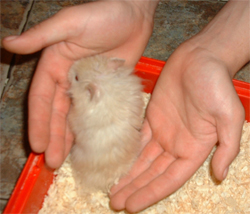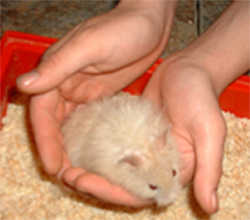| |
Handling Taming Syrian Hamsters
The methods described here refer to the Syrian hamster only, and may not work well with other species of hamsters that are not of a solitary nature. Although all hamsters are territorial the only one of the most popular domesticated species that is of a solitary nature are the Syrian hamster. Other methods may work better with hamsters of a more cordial nature.
Baby hamsters' are very easy to tame. The younger the hamster, the easier it is to tame.
Once you have acquired your new hamster let him settle into his new home for a day or two. This will give your new hamster time to become accustomed to its new surroundings, and of course to your self. During the settling in period you may notice at times the hamster may appear to be washing his face and grooming excessively. This is not a sign of nervous tension as some mistakenly believe, but a natural and instinctive reaction when they are placed in unfamiliar surroundings. What he is actually doing is scenting and laying claim to his new territory. As he places his feet back on the floor he leaves a scent trail, this scent lasts for many day's. Scent marking is used for many purposes; one of those is to help him to recognize different locations within his home and to warn others of his presence. During this period of settling in, approach the cage quietly without sudden moves or any sudden noise. Talk in a low tone and let the pup become accustomed to hearing the sound your voice. In just a few short hours you will get a response from him when you call.
After the initial settling in period it’s time to start socializing your pet. It is said in general practice to place your hand with a treat on it on the bottom of the cage and wait for him to come to you. Regrettably, using this method causes the animal anxiety and stress. Syrian hamsters are fiercely territorial and actions such as this can affect their psychological and physical well being. The more often you intrude onto his territory by placing your hand in his cage and leaving it there, the more stressed he will become. You can sit there for the next 6 months the hamster will not come along willingly and take the treat off you; he will just run away and hide. The least and last thing he is interested in at a time when he is nervous or fearful is food. It could literally take weeks if not months to build his confidence trying to socialize your hamster by this method.
It can take a week or two to a tame a hamster and for him to learn to trust you, but can take only minutes to socialize him enough in which to be handled by hand. The first obstacle we have to overcome is paving the way in getting him used to being handled by human hand. Once this barrier between you both is removed, then taming becomes much easier. The only way you’re going to get your pet used to being handled is to start handling him as soon as possible after the settling in period. Yes, he will be a little apprehensive and may freak out, simply because he is frightened. You will never be able to socialize a hamster solely by offering treats from your hand. Once he is tame and that bond of trust and friendship is formed between you both, then he will freely take treats from your hand.
I socialize baby hamsters every week and do it in a matter of minutes (20 minutes at the most) rather than taking day's or weeks to accomplish it. The longer they take to tame the more resistant they become to being handled. Most young hamsters' are frightened because they do not know what to expect from you. The hamster doesn't realize that you're not going to harm him and the sooner he realizes that the better. Nearly all young hamsters are fearful for their safety and will try to run away and hide. Most will be jumpy at first when trying to handle them, this is just a natural reaction. The method described below will avoid days of stress for you and your pet, and you will gain his confidence and trust much quicker rather than over a longer period of time.
The best time to start socializing him is when he is fully awake and in his own time during the course of the evening, don't wake him during the day to try this. Syrian hamsters are fiercely territorial so this method will work better if he is removed from his own territory i.e. out of the cage. Take him out of his cage about half an hour after he awakes giving him time to feed, drink, and groom. They love exploring new and unfamiliar places, just like he did when you first put him into his new cage. You need to work quickly putting one hand in front of the other so he has little choice but to go from one to the other. If he keeps jumping off your hands, just keep scooping him up again until he stops doing it. Don't grab hold of him, if he's being restrained by folding finger around him, he may nip, just scoop him up and leave him freely to jump off if he feels the need to. Don’t give him time to think about it, keep him moving all the time this will take his mind of other things. Then keeping him under close observation put him down on the sofa, or an arm chair, and watch how differently he reacts to the different scents and surroundings. After a few minutes scoop him again and make him walk from one hand to the other, literally just for a few seconds, then put him down again. This alternating between the hands and putting him down again will help to reassure him you mean no harm when being handled. Again give him another few minutes exploring, then scoop him up and put him back in his cage. Once he realizes you mean him no harm and he is returned safely back to his home you will succeed in getting that first barrier down.
In this Video It will give you some idea of how to work with a hamster. See just how quickly this hamster becomes used to being held in the hands and begins to relax within a few minutes. This hamster is very reluctant to be handled at first, but after a couple of minutes she begins to relax and gain a little more confidence with being held. In the second part of the video I can now start to fold my fingers and thumb around.
 In this video. Taming a young nervous hamster. In this video. Taming a young nervous hamster.
Even when your hamster is tame always let them know that you are about to pick them up.
Never grab a hamster from behind or above this is one sure way of getting a bite from a startled hamster. A startled hamster is a defensive hamster.
 Handling taming hamsters
Handling taming hamsters |

Scooped the hamster up in both hands |

Support the hamster under his rear |
Handling taming hamsters
|
|


